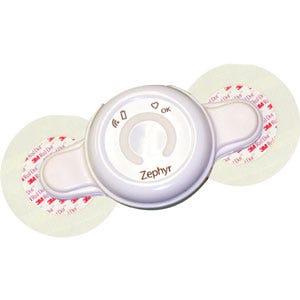So You Want to Develop a Wearable Device...
January 29, 2015
|
Zephyr Anywhere's BioPatch, which measures a patient's vital signs and beams them to caregivers, is an example of a medical-grade wearable. |
Wearables are huge these days, and there is real potential in the field. Not convinced? While it is true that the only wearables to gain traction thus far resemble pedometers on steroids, a growing number of wearables are measuring medically relevant data.
And while these are early days for wearable devices and it is anybody's guess where we end up five to 10 years from now, most analysts are unreservedly optimistic about its market potential. For instance, the market for wearables is projected to be worth upwards of $70 billion by 2024, according to research from IDTechX.
Because of the quickly growing market and the blurring lines between the traditional medical device and consumer tech sectors, the subject is worth the attention of medical device engineers, says Bill Betten, vice president, business solutions in Logic PD's medical division. (Betten will guide a wearables tour and give a talk on the subject at MD&M West. Betten will look at the potential upsides of the devices and the nuts and bolts that make wearable devices tick--and will consider the process of taking a concept for a wearable device from the napkin-sketch stage to a prototype.)
Creating a wearable device starts with making sure you have a crystal clear understanding of the problem you are working on solving, Betten advises. And then consider the number of factors that go into a wearable: there is the type of sensors, battery, analytics, location on the body, technical abilities, security, and aesthetics. Depending on the sensor choice, your wearable could track everything from galvanic skin resistance to pulse oximetry. A number of companies are working on offering cuffless blood pressure and non-invasive blood glucose tracking as well, but creating an affordable wearable device that can tracking those metrics accurately has been an elusive goal thus far. A controversial startup even claims to be able to track caloric expenditure through the skin.
It's worth noting that the data coming from most of the current wearable devices isn't correlatable to any other device. Software like Apple's Health app, which is designed to be a dashboard for health metrics, could potentially help integrate data from wearables and other sources. But the first version of that software has fallen short of expectations.
A bigger problem is that much of the data being gathered by wearables is not really medically relevant. But don't think that wearables are destined to always be toys that track little more than your steps. "The interest that many consumers are showing in monitoring themselves and the speed at which the technology is moving should send a warning message to the medical companies," Betten says. In addition, the pace of development in the consumer wearables field is moving much faster than the medtech industry is used to. "I think you are going to have an awful lot of companies staking out the gray zone between the traditional medical device and consumer health-tracking technologies," he predicts.
One factor that could drive progress in the wearables field is the need for technology to help address the uptick in chronic conditions, which is one of the most significant drivers of the escalating healthcare costs in the United States. Wearable devices could help patients quantify their health and thus assist in chronic disease management. But the challenge there is adherence. Getting a patient to consistently use a wearable device on a daily basis, let alone stick to a prescription drug regimen, is a major challenge.
Some consumers--and maybe even insurance companies and CMS--will undoubtedly want wearables that track medically relevant metrics. There is thus a need for at least some wearables to be created that bear FDA's stamp of approval. Now is the time for medical device professionals to familiarize themselves with this field. While most makers of consumer-facing wearables don't presently have the skills to get a device through the FDA approval process, it would be a mistake to underestimate them this early in the game.
Bill Betten will guide two tours related to wearables at MD&M West in Anaheim, CA. |
Brian Buntz is the editor-in-chief of MPMN and Qmed. Follow him on Twitter at @brian_buntz.
Like what you're reading? Subscribe to our daily e-newsletter.
About the Author(s)
You May Also Like



